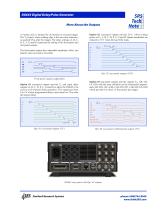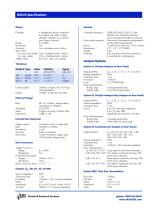
Catalog excerpts

Digital Delay/Pulse Generator DG645 — Digital delay and pulse generator (4 or 8 channels) DG645 Digital Delay/Pulse Generator · 4 pulse, 8 delay outputs (opt.) · <25 ps rms jitter · Trigger rates to 10 MHz · Precision rate generator · Easy synchronization with 80 MHz mode locked lasers · Fast transition times · Ovenized crystal or Rb timebase (opt.) · Ethernet, GPIB and RS-232 interfaces The DG645 is a versatile digital delay/pulse generator that provides precisely defined pulses at repetition rates up to 10 MHz. The instrument offers several improvements over older designs — lower jitter, higher accuracy, faster trigger rates, and more outputs. The DG645 also has Ethernet, GPIB and RS-232 interfaces for computer or network control of the instrument. Delay Generator Timing All digital delay generators measure time intervals by counting cycles of a fast clock (typically 100 MHz). Most digital delay generators also have short programmable analog delays to achieve time intervals with finer resolution than the clock period. Unfortunately, one clock cycle of timing indeterminacy (typically 10 ns) can occur if the trigger is not in phase with the clock. The DG645 eliminates timing indeterminacy by measuring the timing of triggers with respect to the internal clock and compensating the analog delays. This approach reduces the jitter by about 100× and allows the internal rate generator to operate at any rate — not just a sub-multiple of the clock frequency. Triggering Stanford Research Systems The DG645 has many trigger modes. An internal rate generator, with less than 100 ps period jitter, may be set
Open the catalog to page 1
DG645 Digital Delay/Pulse Generator File Control Setup Measure Analyze Utilities Help 2:25 PM Combinatorial outputs showing 3 ns, 5 ns and 10 ns pulses with 1 ns transition times (5ns/div) and output offsets can range over ±2 VDC to source virtually any logic level (NIM, ECL, PECL, CMOS, etc.). Output transition times are less than 2 ns at any output amplitude. Rear-Panel Outputs Optional rear-panel outputs are available to support diverse applications. Option 01 provides a T0 output and eight logic levels, with transition times less than 1 ns. Option 02 provides these same outputs but as...
Open the catalog to page 2
DG645 Digital Delay/Pulse Generator Ideal External Timebase Jitter vs. programmed delay Timebases The standard time base has an accuracy of 5 ppm, and a jitter of 10–8, which is suitable for many applications. Optional timebases are available for users who require better rate and delay accuracy or reduced rate and delay jitter. The timing error for a 1 s delay can be as large as 5 µs for the standard timebase, 200 ns for the OCXO timebase, but is only 500 ps for the rubidium timebase (all 1 year after calibration.) DG645 (cover removed) with optional Rb timebase. Rear panel shows the...
Open the catalog to page 3
DG645 Digital Delay/Pulse Generator More About the Outputs A timing cycle is initiated by an internal or external trigger. The T0 output, whose leading edge is the zero-time reference, is asserted 85 ns after the trigger. The delay settings (A, B, C, D, E, F, G and H) determine the timing of the front-panel and rear-panel outputs. The front-panel outputs have adjustable amplitude, offset, and polarity (non-inverted or inverted). Opt. 02 rear-panel outputs (30 V) Front-panel outputs (adjustable) Option 01 rear-panel outputs provide T0 and eight delay outputs (A, B, C, D, E, F, G and H) to...
Open the catalog to page 4
Channels 4 independent pulses controlled in position and width. 8 delay channels available as an option (see Output Options). Range 0 to 2000 s Resolution 5 ps Accuracy 1 ns + (timebase error × delay) Jitter (rms) Ext. trig. to any output 25 ps + (timebase jitter × delay) T0 to any output 15 ps + (timebase jitter × delay) Trigger delay 85 ns (ext. trig. to T0 output) Computer interfaces GPIB (IEEE-488.2), RS-232, and Ethernet. All instrument functions can be controlled through the interfaces. Non-volatile memory Nine sets of instrument configurations can be stored and recalled. Power <100...
Open the catalog to page 5All Stanford Research Systems catalogs and technical brochures
-
SR556
1 Pages
-
QMSc
3 Pages
-
FS730/1
4 Pages
-
SC10
2 Pages
-
PRS10
4 Pages
-
SR715/720
3 Pages
-
CG635
5 Pages
-
PERF10
2 Pages
-
SR865 DSP Lock-In Amplifier
5 Pages
-
SIM984 — Isolation amplifier
1 Pages
-
SR620
4 Pages
-
SR280Mainframe and Display
1 Pages
-
SIM900Mainframe
2 Pages
-
SIM914350 MHz Preamplifier
1 Pages
-
SIM964Analog Limiter
1 Pages
-
SIM970Quad Digital Voltmeter
2 Pages
-
SIM983Scaling Amplifier
1 Pages
-
SIM965Analog Filter
2 Pages
-
SIM921AC Resistance Bridge
3 Pages
-
SR250Gated Integrator
3 Pages
-
SR240A350 MHz Preamplifier
1 Pages
-
SR540 Optical Chopper
1 Pages
-
SR640 Programmable Filters
3 Pages
-
Rubidium Frequency Standard
4 Pages
-
LCR Meters
3 Pages
-
Synthesized Clock Generator
5 Pages
-
UGAUniversal Gas Analyzer
3 Pages
-
RGAResidual Gas Analyzers
5 Pages
-
SR850DSP Lock-In Amplifier
4 Pages
-
FS710Distribution Amplifier
1 Pages
-
SR10/11/12Audio Switchers
2 Pages
-
SR1Audio Analyzer
6 Pages
-
6 GHz Vector Signal Generator
10 Pages
-
SR255Fast Sampler
3 Pages
-
SR245 Computer Interface
2 Pages
-
SR200 Gate Scanner
1 Pages
-
SR552 BJT Input Preamplifier
1 Pages
-
SR550 FET Input Preamplifier
1 Pages
-
SR445A 350 MHz Preamplifier
1 Pages
-
SR630 Thermocouple Reader
3 Pages
-
CT100 SRS Instrument Cart
1 Pages
-
SR510/530 Lock-In Amplifiers
4 Pages
-
IGC100 Ion Gauge Controller
4 Pages
-
NL100 Nitrogen Laser
2 Pages
-
SIM980 Summing Amplifier
1 Pages
-
SR235 Analog Processor
1 Pages
-
Laser Diode Controller
4 Pages
-
DS335 Function Generator
2 Pages
-
Audio Switchers
2 Pages
Archived catalogs
-
Partial Pressure Monitor
2 Pages
-
Analog PID Controller
2 Pages
-
Optical Chopper
2 Pages
-
Programmable Filters
3 Pages
-
Distribution Amplifier
1 Pages
-
Audio Analyzer
6 Pages
-
Residual Gas Analyzers
5 Pages
-
Photon Counters
6 Pages
-
Waveform Generator
2 Pages
-
Lock in Amplifiers
3 Pages
-
DSP Lock-in Amplifier
3 Pages



















































































































































